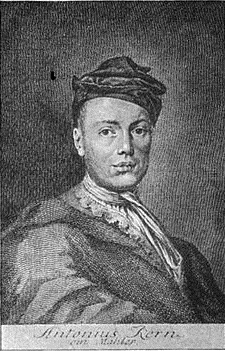
The Church of St. Ignatius of Loyola at Campus Martius is a Latin Catholic titular church, of deaconry rank, dedicated to Ignatius of Loyola, the founder of the Society of Jesus, located in Rome, Italy. Built in Baroque style between 1626 and 1650, the church functioned originally as the chapel of the adjacent Roman College, which moved in 1584 to a new larger building and was renamed the Pontifical Gregorian University. It is one of the great 17th century preaching churches built by Counter-Reformation orders in the Centro Storico.

Uherské Hradiště is a town in the Zlín Region of the Czech Republic. It has about 25,000 inhabitants. The agglomeration with the two neighbouring towns of Staré Město and Kunovice has over 37,000 inhabitants.

The Church of the Gesù is the mother church of the Society of Jesus (Jesuits), a Catholic religious order. Officially named Chiesa del Santissimo Nome di Gesù, its façade is "the first truly baroque façade", introducing the baroque style into architecture. The church served as a model for innumerable Jesuit churches all over the world, especially in Central Europe and in Portuguese colonies. Its paintings in the nave, crossing, and side chapels became models for art in Jesuit churches throughout Italy and Europe, as well as those of other orders. The Church of the Gesù is located at the Piazza del Gesù in Rome, and is one of the great 17th century preaching churches built by Counter-Reformation orders like the Jesuits in the Centro Storico.

Velké Hoštice is a municipality and village in Opava District in the Moravian-Silesian Region of the Czech Republic. It has about 1,800 inhabitants. It is part of the historic Hlučín Region.

Andrea Pozzo was an Italian Jesuit brother, Baroque painter, architect, decorator, stage designer, and art theoretician.

Karel Škréta Šotnovský of Závořice was a portrait painter from Bohemia who worked in the Baroque style. He lived through the Thirty Years' War which caused him some hardships as a Protestant which led him to leave Prague for Saxony then Italy.
Carlo Lurago was an Italian architect who was active in Prague.

The Church of the Mother of God before Týn, or Church of Our Lady before Týn, is a Gothic church and a dominant feature of the Old Town of Prague, Czech Republic. It has been the main church of this part of the city since the 14th century. The church's two towers are 80 m high, and each tower's spire is topped by eight smaller spires in two layers of four.

The Church of the Holy Trinity is a Roman Catholic parish church in Fulnek, Czech Republic. Built in the 18th century, it is architecturally and culturally significant as one of the most valuable baroque buildings of northeast Moravia. It is situated on the site of the original parish church, whose existence was documented in the 13th century.

Czech Baroque architecture refers to the architectural period of the 17th and 18th century in Bohemia, Moravia and Silesia, which comprised the Crown of Bohemia and today constitute the Czech Republic.
Jan Jiří Heinsch or Heintsch was a Czech-German Baroque style artist. Heinsch primarily painted religious-themed works as well as portraits of monastic superiors – especially for various Catholic religious orders such as the Jesuits, Knights of the Cross with the Red Star or Augustinians. He is known to have produced around 150 paintings and, in addition, extensive graphic work.
Josef Kramolín was a Czech Jesuit brother and painter. He primarily painted religious-themed frescoes.

Felix Ivo Leicher was a Czech-Austrian painter of altarpieces and secular works, which was spread to a wide area throughout the Habsburg Empire and beyond.
Jan Kryštof Liška was a Czech Baroque painter. His works mainly included altarpieces and frescoes.

St. Ignatius Church is a Roman Catholic church, located in Charles Square, Prague, in the Czech Republic.

Anton Kern or Körne was a Bohemian-born painter; primarily of religious and historical scenes.

Adolf Kajpr SJ was a Czech Catholic priest, Jesuit and publisher of Catholic printed matter. As an ardent preacher, confessor, spiritual leader and journalist, he commented not only on fundamental topics of the Catholic faith but also on current social and political issues. For his opinions he was imprisoned by the Nazis (1941–1945) and the communists (1950–1959). After nine years in the communist prison, he died at the age of 57 “with a reputation of holiness and martyrdom”.

Jan de Herdt, in Italy also called Il fiammingo was a Flemish painter and draughtsman. After training in Antwerp, he spent his entire career abroad, first in Northern Italy and later in Vienna and other cities in central Europe. He was mainly a portrait artist but also painted genre scenes as well as religious, mythological and allegorical subjects. He was part of a network of Flemish and Dutch painters working for the court, aristocracy and ecclesiastical institutions of central Europe.

Crucifixion from Nové Sady, is part of a larger altar polyptych called the Rajhrad Altarpiece. Its author is the last important personality of Czech panel painting of the pre-Hussite period, known as the Master of the Rajhrad Altarpiece. The painting is on display in the permanent exhibition of the National Gallery in Prague.















